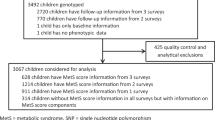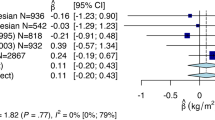Abstract
Objective:
Recent genome-wide association studies (GWAS) have identified 38 obesity-associated loci among European populations. However, their contribution to obesity in other ethnicities is largely unknown.
Methods:
We utilised five GWAS (N=10 482) from Chinese (three cohorts, including one with type 2 diabetes and another one of children), Malay and Indian ethnic groups from Singapore. Data sets were analysed individually and subsequently in combined meta-analysis for Z-score body-mass index (BMI) associations.
Results:
Variants at the FTO locus showed the strongest associations with BMI Z-score after meta-analysis (P-values 1.16 × 10−7–7.95 × 10−7). We further detected associations with nine other index obesity variants close to the MC4R, GNPDA2, TMEM18, QPCTL/GIPR, BDNF, ETV5, MAP2K5/SKOR1, SEC16B and TNKS/MSRA loci (meta-analysis P-values ranging from 3.58 × 10−4–1.44 × 10−2). Three other single-nucleotide polymorphisms (SNPs) from CADM2, PTBP2 and FAIM2 were associated with BMI (P-value ⩽0.0418) in at least one dataset. The neurotrophin/TRK pathway (P-value=0.029) was highlighted by pathway-based analysis of loci that had statistically significant associations among Singaporean populations.
Conclusion:
Our data confirm the role of FTO in obesity predisposition among Chinese, Malays and Indians, the three major Asian ethnic groups. We additionally detected associations for 12 obesity-associated SNPs among Singaporeans. Thus, it is likely that Europeans and Asians share some of the genetic predisposition to obesity. Furthermore, the neurotrophin/TRK signalling may have a central role for common obesity among Asians.
This is a preview of subscription content, access via your institution
Access options
Subscribe to this journal
Receive 12 print issues and online access
$259.00 per year
only $21.58 per issue
Buy this article
- Purchase on Springer Link
- Instant access to full article PDF
Prices may be subject to local taxes which are calculated during checkout

Similar content being viewed by others
References
Walley AJ, Asher JE, Froguel P . The genetic contribution to non-syndromic human obesity. Nat Rev Genet 2009; 10: 431–442.
Willer CJ, Speliotes EK, Loos RJ, Li S, Lindgren CM, Heid IM et al. Genetic investigation of anthropometric traits consortium: six new loci associated with body mass index highlight a neuronal influence on body weight regulation. Nat Genet 2009; 41: 25–34.
Thorleifsson G, Walters GB, Gudbjartsson DF, Steinthorsdottir V, Sulem P, Helgadottir A et al. Genome-wide association yields new sequence variants at seven loci that associate with measures of obesity. Nat Genet 2009; 41: 18–24.
Speliotes EK, Willer CJ, Berndt SI, Monda KL, Thorleifsson G, Jackson AU et al. Association analyses of 249 796 individuals reveal 18 new loci associated with body mass index. Nat Genet 2010; 42: 937–948.
Meyre D, Delplanque J, Chèvre JC, Lecoeur C, Lobbens S, Gallina S et al. Genome-wide association study for early-onset and morbid adult obesity identifies three new risk loci in European populations. Nat Genet 2009; 41: 157–159.
Scherag A, Dina C, Hinney A, Vatin V, Scherag S, Vogel CI et al. Two new loci for body-weight regulation identified in a joint analysis of genome-wide association studies for early-onset extreme obesity in French and German study groups. PLoS Genet 2010; 6: e1000916.
Tan JT, Dorajoo R, Seielstad M, Sim XL, Ong RT, Chia KS et al. FTO variants are associated with obesity in the Chinese and Malay populations in Singapore. Diabetes 2008; 57: 2851–2857.
Cha SW, Choi SM, Kim KS, Park BL, Kim JR, Kim JY et al. Replication of genetic effects of FTO polymorphisms on BMI in a Korean population. Obesity (Silver Spring) 2008; 16: 2187–2189.
Loos RJ, Lindgren CM, Li S, Wheeler E, Zhao JH, Prokopenko I et al. Common variants near MC4R are associated with fat mass, weight and risk of obesity. Nat Genet 2008; 40: 768–775.
Chambers JC, Elliott P, Zabaneh D, Zhang W, Li Y, Froguel P et al. Common genetic variation near MC4R is associated with waist circumference and insulin resistance. Nat Genet 2008; 40: 716–718.
Cheung CYY, Tso AWK, Cheung BMY, Xu A, Ong KL, Fong CHY et al. Obesity susceptibility genetic variants identified from recent genome-wide association studies: implication in a Chinese population. J Clin Endocrinol Metab 2010; 95: 1395–1403.
Shi J, Long J, Gao Y, Lu W, Cai Q, Wen W et al. Evaluation of genetics susceptibility loci for obesity in Chinese women. Am J Epidemiol 2010; 172: 244–254.
Hotta K, Nakamura M, Nakamura TT, Nakata Y, Kamohara S, Nobuyuki M et al. Association between obesity and polymorphisms in SEC16B, TMEM18, GNPDA2, BDNF, FAIM2 and MC4R in a Japanese population. J Hum Genet 2009; 54: 727–731.
Ng MCY, Tam CHT, So WY, Ho JSK, Chan AW, Lee HM et al. Implication of genetic variants near NEGRI, SEC16, TMEM18, ETV5/DGKG, GNPDA2, LIN7C/BDNF, MTCH2, BCDIN3D/FAIM2, SH2B1, FTO, MC4R and KCTD15 with obesity and type 2 diabetes in 7705 Chinese. J Clin Endocrinol Metab 2010; 95: 2418–2425.
Adan RA, Tiesjema B, Hillebrand JJ, la Fleur SE, Kas MJ, de Krom M . The MC4 receptor and control of appetite. Br J Pharmacol 2006; 149: 815–827.
Lebrun B, Bariohay B, Moyse E, Jean A . Brain-derived neurotrophic factor (BDNF) and food intake regulation: a minireview. Auton Neurosci 2006; 30: 126–127.
Fariñas I, Wilkinson GA, Backus C, Reichardt LF, Patapoutian A . Characterization of neurotrophin and Trk receptor functions in developing sensory ganglia: direct NT-3 activation of TrkB neurons in vivo. Neuron 1998; 21: 325–334.
Miyawaki K, Yamada Y, Ban N, Ihara Y, Tsukiyama K, Zhou H et al. Inhibition of gastric inhibitory polypeptide signaling prevents obesity. Nature Med 2002; 8: 738–742.
Shuldiner AR . Obesity genes and gene-environment-behavior interactions: recommendations for a way forward. Obesity (Silver Spring) 2008; 16 (Suppl 3): S79–S81.
Zeggini E, Ioannidis JPA . Meta-analysis in genome-wide association studies. Pharmacogenomics 2009; 10: 191–201.
Author information
Authors and Affiliations
Corresponding authors
Ethics declarations
Competing interests
The authors declare no conflict of interest.
Additional information
Supplementary Information accompanies the paper on International Journal of Obesity website
Rights and permissions
About this article
Cite this article
Dorajoo, R., Blakemore, A., Sim, X. et al. Replication of 13 obesity loci among Singaporean Chinese, Malay and Asian-Indian populations. Int J Obes 36, 159–163 (2012). https://doi.org/10.1038/ijo.2011.86
Received:
Revised:
Accepted:
Published:
Issue Date:
DOI: https://doi.org/10.1038/ijo.2011.86
Keywords
This article is cited by
-
Gene-diet interaction effects on BMI levels in the Singapore Chinese population
Nutrition Journal (2018)
-
Genome-wide association study identifies a missense variant at APOA5 for coronary artery disease in Multi-Ethnic Cohorts from Southeast Asia
Scientific Reports (2017)
-
Role of a common variant of Fat Mass and Obesity associated (FTO) gene in obesity and coronary artery disease in subjects from Punjab, Pakistan: a case control study
Lipids in Health and Disease (2016)
-
Association of BDNF Polymorphisms with the Risk of Epilepsy: a Multicenter Study
Molecular Neurobiology (2016)
-
Genetics of Obesity
Indian Journal of Clinical Biochemistry (2016)



